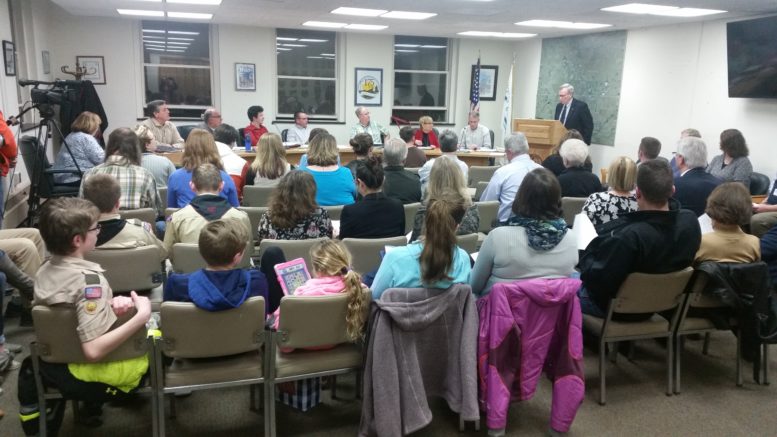By JAN LARSON McLAUGHLIN
BG Independent News
Bowling Green Mayor Dick Edwards is tired of hearing conflicting “facts” about the pipeline proposed to cross city property and run close to the city water treatment plant.
So he set out himself to find some “good science” instead of “unsubstantiated political statements.”
The city has been asked by those opposed to the Nexus pipeline to try to intervene in the FERC approval process, but council has been reluctant to get into a losing court battle.
So Edwards turned to two scientists for help. One is Dr. Charles Onasch, professor emeritus of geology at BGSU, a researcher who has probably studied the BG Fault more than anyone else on record, Edwards said. The other is Larry Wickstrom, president of Wickstrom Geoscience of Worthington, Ohio, who is the former chief of the Ohio Division of the Ohio Geological Survey.
“In that important role, he warned of some of the potential dangers associated with fracking in southeastern Ohio, and as a result lost his job,” Edwards said of Wickstrom.
While other geologists have presented some alarming information about the pipeline route, the geologists the mayor talked with do not share those concerns.
“I take science very seriously,” Edwards assured those at the council meeting. “We’ve been doing a lot of investigating and trying to reach out to some of the best minds we know.”
The geologists the mayor contacted said the most recent activity on the Bowling Green Fault can be no younger than the 10,000- to 20,000-year-old glacial sediments that are undisturbed by the fault. An extensive network of pipelines cross various fault lines in the area with no reported difficulties. And the Ohio Geological Survey has identified all the karst (natural sinkhole areas) in Ohio, with none in Wood County.
“In summary, the probability of any complications developing with the water treatment process and the water supply in BG in relationship to the Fault and the proposed gas line is extremely low,” the mayor said. That cannot be said for other areas of the state, where the geological characteristics cause more concerns.
Edwards said he has plans to speak with more geologists about the project.
Council member Daniel Gordon questioned why geologists have varying opinions, given the same factors. Edwards said that is unclear, but added that all of the geologists involved so far have pointed to Onasch as the expert.
Council president Mike Aspacher thanked the mayor for the report and said council will welcome additional information gathered by Edwards.
Council member John Zanfardino said he appreciated the mayor’s information, but noted that data presented on the risks of the pipeline have been mixed.
Lisa Kochheiser, an opponent of the Nexus pipeline, also thanked Edwards for his report.
“I appreciate you for taking it seriously,” she said.
But she said the pipeline company is skirting science evaluation by failing to identify the BG Fault and the city’s water treatment plant in the pipeline plans as potential risk factors. She said the high impact drilling technique used for the pipeline will put the river at risk.
“The city should be demanding a halt,” Kochheiser said, asking City Council to intervene in the pipeline approval process. “It is absolutely our right, and our obligation to protect our water.”
Council member Bruce Jeffers said he appreciated the information from the mayor and from environmentalists on the pipeline. But council has no plans to file a motion to intervene on the pipeline, he said.
“I think this is the best course of action for us, to work in concert with the mayor,” Jeffers said.
Also at Tuesday’s meeting, Stephanie Lauwers presented concerns about the new garbage rules that affect her parents, Jim and Ruth Heider, who live at 811 W. Wooster St. Prior to the new rules going into effect, her parents’ garbage was one of a few in the city where container service was provided for residents with physical handicaps.
Because her parents’ driveway is about 200 feet long, it no longer qualifies for the service unless the containers are moved within 75 feet of the street on pickup days. Lauwers asked that council either reconsider the driveway length limit, or grandfather her parents’ home.
Council president Mike Aspacher said he would meet with city administration and public works staff to discuss the issue.
In other business at Tuesday’s City Council meeting:
- Edwards announced that the Bowling Green waterline serving the village of Waterville went into service on Tuesday.
- Municipal Administrator Lori Tretter said the city’s solar field has reached 20 megawatt peaks on four of the last five days.
- Council held an executive session on labor negotiations and real estate, but took no action.
- Planning Director Heather Sayler said the Community Action Plan charts are available for public view on the second floor of the city administration building, and are on the city’s website.
- Sayler reported the new Good Neighbor Guide is on the city website. One more edit is expected before it is complete.
- Sayler also noted the city has received 23 zoning permit requests this year, including six for single-family homes.
- Craft said new recycling graphics are being placed on residential recycling bins. The new stickers have more information on which items are accepted at the recycling center.
- It was announced that Aspacher will serve on the executive committee of the Toledo Metropolitan Area Council of Governments.
- BGSU student Sarah Schwiefert updated council on Dance Marathon plans.
- Members of Boy Scout Troop 422 attended the meeting.

